Gravitational radiation by a single particle¶
Gravitational radiation by a particle on a circular orbit around a Kerr black hole
The gravitational wave emitted by a particle of mass \(\mu\) on a circular orbit in the equatorial plane of a Kerr black hole of mass \(M\) and angular momentum parameter \(a\) is given by the formula:
where
\(h_+ = h_+(t,r,\theta,\phi)\) and \(h_\times = h_\times(t,r,\theta,\phi)\), \((t,r,\theta,\phi)\) being the Boyer-Lindquist coordinates of the observer
\(r_*\) is the tortoise coordinate corresponding to \(r\)
\(r_0\) is the Boyer-Lindquist radius of the particle’s orbit
\(\phi_0\) is some constant phase factor
\(\omega_0\) is the orbital angular velocity
\(Z^\infty_{\ell m}(r_0)\) is a solution of the radial component of the Teukolsky equation (cf.
Zinf())\(_{-2}S^{am\omega_0}_{\ell m}(\theta,\phi)\) is the spin-weighted spheroidal harmonic of weight \(-2\) (cf.
spin_weighted_spheroidal_harmonic())
According to Eq. (1), the Fourier-series expansion of the waveform \((h_+,h_\times)\) received at the location \((t,r,\theta,\phi)\) is
where
\(\omega_0\) being the orbital angular velocity of the particle and \(r_*\) the tortoise coordinate corresponding to \(r\).
Note that the dependence of the Fourier coefficients \(A_m^{+,\times}(r,\theta)\) and \(B_m^{+,\times}(r,\theta)\) with respect to \(r\) is simply \(\mu/r\), where \(\mu\) is the particle’s mass, i.e. we may consider the following rescaled Fourier coefficients, which depend on \(\theta\) only:
According to Eqs. (1) and (2), we have
This module implements the following functions:
h_plus_particle(): evaluates \(r h_+/\mu\) via Eq. (2)h_cross_particle(): evaluates \(r h_\times/\mu\) via Eq. (2)h_particle_quadrupole(): evaluates \(r h_+/\mu\) or \(r h_\times/\mu\) at the quadrupole approximationh_plus_particle_fourier(): evaluates \(r A_m^+/\mu\) and \(r B_m^+/\mu\) via Eqs. (3)-(4)h_cross_particle_fourier(): evaluates \(r A_m^\times/\mu\) and \(r B_m^\times/\mu\) via Eqs. (5)-(6)h_amplitude_particle_fourier(): evaluates \((r/\mu)\sqrt{(A_m^+)^2 + (B_m^+)^2}\) and \((r/\mu)\sqrt{(A_m^\times)^2 + (B_m^\times)^2}\)h_particle_signal(): time sequence of \(r h_+/\mu\) or \(r h_\times/\mu\)plot_h_particle(): plot \(r h_+/\mu\) and/or \(r h_\times/\mu\) in terms of the retarded timeplot_spectrum_particle(): plot \((r/\mu)\sqrt{(A_m^{+,\times})^2 + (B_m^{+,\times})^2}\) in terms of \(m\)radiated_power_particle(): total radiated power (gravitational luminosity)secular_frequency_change(): change in orbital frequency \(\dot{\omega_0}/\omega_0\) due to the gravitational radiation reactiondecay_time(): time for the orbit to shrink to an orbit of given radius
REFERENCES:
S. A. Teukolsky, Astrophys. J. 185, 635 (1973)
S. Detweiler, Astrophys. J. 225, 687 (1978)
M. Shibata, Phys. Rev. D 50, 6297 (1994)
D. Kennefick, Phys. Rev. D 58, 064012 (1998)
S. A. Hughes, Phys. Rev. D 61, 084004 (2000) [doi:10.1103/PhysRevD.61.084004]
E. Gourgoulhon, A. Le Tiec, F. Vincent, N. Warburton, Astron. Astrophys. 627, A92 (2019) [doi:10.1051/0004-6361/201935406]; Arxiv 1903.02049
- kerrgeodesic_gw.gw_particle.decay_time(a, r_init, r_final, l_max=None, m_min=1, approximation=None, quad_epsrel=1e-06, quad_limit=500)¶
Return the time spent in the migration from a circular orbit of radius
r_initto that of radiusr_final, induced by gravitational radiation reaction.INPUT:
a– BH angular momentum parameter (in units of \(M\), the BH mass)r_init– Boyer-Lindquist radius of the initial orbit (in units of \(M\))r_final– Boyer-Lindquist radius of the final orbit (in units of \(M\))l_max– (default:None) upper bound in the summation over the harmonic degree \(\ell\); ifNone,l_maxis determined automatically from the available tabulated datam_min– (default: 1) lower bound in the summation over the Fourier mode \(m\)approximation– (default:None) string describing the computational method; allowed values areNone: exact computation'1.5PN'(only fora=0): 1.5-post-Newtonian expansion following E. Poisson, Phys. Rev. D 47, 1497 (1993) [doi:10.1103/PhysRevD.47.1497]'quadrupole'(only fora=0): quadrupole approximation (0-post-Newtonian); seeh_particle_quadrupole()
quad_epsrel– (default:1.e-6) relative error tolerance in the computation of the integral giving the decay timequad_limit– (default:500) upper bound on the number of subintervals used in the adaptive algorithm to compute the integral (this corresponds to the argumentlimitof SciPy’s function quad)
OUTPUT:
rescaled decay time \(T (\mu/M^2)\), where \(M\) is the BH mass and \(\mu\) the mass of the orbiting particle.
EXAMPLES:
Time to migrate from \(r_0=10 M\) to \(r_0=6 M\) around a Schwarzschild black hole:
sage: from kerrgeodesic_gw import decay_time sage: decay_time(0, 10, 6) # tol 1.0e-13 90.80876605028857
Let us check that at large radius, there is a good agreement with the quadrupole formula:
sage: decay_time(0, 50, 6) # tol 1.0e-13 121893.29664651724 sage: decay_time(0, 50, 6, approximation='quadrupole') # tol 1.0e-13 122045.0
- kerrgeodesic_gw.gw_particle.h_amplitude_particle_fourier(m, a, r0, theta, l_max=10, algorithm_Zinf='spline')¶
Return the amplitude Fourier mode of a given order \(m\) of the rescaled gravitational wave emitted by a particle in circular orbit around a Kerr black hole.
The rescaled Fourier mode of order \(m\) received at the location \((t,r,\theta,\phi)\) is
\[\frac{r}{\mu} h_m^{+,\times} = {\bar A}_m^{+,\times} \cos(m\psi) + {\bar B}_m^{+,\times} \sin(m\psi)\]where \(\mu\) is the particle mass and \(\psi := \omega_0 (t-r_*) - \phi\), \(\omega_0\) being the orbital frequency of the particle and \(r_*\) the tortoise coordinate corresponding to \(r\) and \({\bar A}_m^{+,\times}\) and \({\bar B}_m^{+,\times}\) are given by Eqs. (3)-(6) above.
The \(+\) and \(\times\) amplitudes of the Fourier mode \(m\) are defined respectively by
\[\frac{r}{\mu} |h_m^+| := \sqrt{({\bar A}_m^+)^2 + ({\bar B}_m^+)^2} \quad\mbox{and}\quad \frac{r}{\mu} |h_m^\times| := \sqrt{({\bar A}_m^\times)^2 + ({\bar B}_m^\times)^2}\]INPUT:
m– positive integer defining the Fourier modea– BH angular momentum parameter (in units of \(M\), the BH mass)r0– Boyer-Lindquist radius of the orbit (in units of \(M\))theta– Boyer-Lindquist colatitute \(\theta\) of the observerl_max– (default: 10) upper bound in the summation over the harmonic degree \(\ell\) in Eqs. (3)-(6)algorithm_Zinf– (default:'spline') string describing the computational method for \(Z^\infty_{\ell m}(r_0)\); allowed values are'spline': spline interpolation of tabulated data'1.5PN'(only fora=0): 1.5-post-Newtonian expansion following E. Poisson, Phys. Rev. D 47, 1497 (1993) [doi:10.1103/PhysRevD.47.1497]
OUTPUT:
tuple \(((r/\mu)|h_m^+|,\ (r/\mu)|h_m^\times|)\) (cf. the above expression)
EXAMPLE:
For a Schwarzschild black hole (\(a=0\)):
sage: from kerrgeodesic_gw import h_amplitude_particle_fourier sage: a = 0 sage: h_amplitude_particle_fourier(2, a, 6., pi/2) # tol 1.0e-13 (0.27875846152963557, 1.5860176188287866e-16) sage: h_amplitude_particle_fourier(2, a, 6., pi/4) # tol 1.0e-13 (0.47180033963220214, 0.45008696580919527) sage: h_amplitude_particle_fourier(2, a, 6., 0) # tol 1.0e-13 (0.6724377101568336, 0.6724377101568336) sage: h_amplitude_particle_fourier(2, a, 6., pi/4, l_max=5) # tol 1.0e-13 (0.47179830286565255, 0.4500948389153302) sage: h_amplitude_particle_fourier(2, a, 6., pi/4, l_max=5, # tol 1.0e-13 ....: algorithm_Zinf='1.5PN') (0.5381495951380861, 0.5114366815383188)
For a rapidly rotating Kerr black hole (\(a=0.95 M\)):
sage: a = 0.95 sage: h_amplitude_particle_fourier(2, a, 6., pi/4) # tol 1.0e-13 (0.39402068296301823, 0.37534143024659444) sage: h_amplitude_particle_fourier(2, a, 2., pi/4) # tol 1.0e-13 (0.7358730645589858, 0.7115113031184368)
- kerrgeodesic_gw.gw_particle.h_cross_particle(a, r0, u, theta, phi, phi0=0, l_max=10, m_min=1, algorithm_Zinf='spline')¶
Return the rescaled \(h_\times\)-part of the gravitational radiation emitted by a particle in circular orbit around a Kerr black hole.
The computation is based on Eq. (2) above.
INPUT:
a– BH angular momentum parameter (in units of \(M\), the BH mass)r0– Boyer-Lindquist radius of the orbit (in units of \(M\))u– retarded time coordinate of the observer (in units of \(M\)): \(u = t - r_*\), where \(t\) is the Boyer-Lindquist time coordinate and \(r_*\) is the tortoise coordinatetheta– Boyer-Lindquist colatitute \(\theta\) of the observerphi– Boyer-Lindquist azimuthal coordinate \(\phi\) of the observerphi0– (default: 0) phase factorl_max– (default: 10) upper bound in the summation over the harmonic degree \(\ell\)m_min– (default: 1) lower bound in the summation over the Fourier mode \(m\)algorithm_Zinf– (default:'spline') string describing the computational method for \(Z^\infty_{\ell m}(r_0)\); allowed values are'spline': spline interpolation of tabulated data'1.5PN'(only fora=0): 1.5-post-Newtonian expansion following E. Poisson, Phys. Rev. D 47, 1497 (1993) [doi:10.1103/PhysRevD.47.1497]
OUTPUT:
the rescaled waveform \((r / \mu) h_\times\), where \(\mu\) is the particle’s mass and \(r\) is the Boyer-Lindquist radial coordinate of the observer
EXAMPLES:
Let us consider the case \(a=0\) (Schwarzschild black hole) and \(r_0=6 M\) (emission from the ISCO). For \(\theta=\pi/2\), we have \(h_\times=0\):
sage: from kerrgeodesic_gw import h_cross_particle sage: a = 0 sage: h_cross_particle(a, 6., 0., pi/2, 0.) # tol 1.0e-13 1.0041370414185673e-16
while for \(\theta=\pi/4\), we have:
sage: h_cross_particle(a, 6., 0., pi/4, 0.) # tol 1.0e-13 0.275027796440582 sage: h_cross_particle(a, 6., 0., pi/4, 0., l_max=5) # tol 1.0e-13 0.2706516303570341 sage: h_cross_particle(a, 6., 0., pi/4, 0., l_max=5, algorithm_Zinf='1.5PN') # tol 1.0e-13 0.2625307460899205
For an orbit of larger radius (\(r_0=12 M\)), the 1.5-post-Newtonian approximation is in better agreement with the exact computation:
sage: h_cross_particle(a, 12., 0., pi/4, 0.) 0.1050751824554463 sage: h_cross_particle(a, 12., 0., pi/4, 0., l_max=5, algorithm_Zinf='1.5PN') # tol 1.0e-13 0.10244926162224487
A plot of the waveform generated by a particle orbiting at the ISCO:
sage: hc = lambda u: h_cross_particle(a, 6., u, pi/4, 0.) sage: plot(hc, (0, 200.), axes_labels=[r'$(t-r_*)/M$', r'$r h_\times/\mu$'], ....: gridlines=True, frame=True, axes=False) Graphics object consisting of 1 graphics primitive
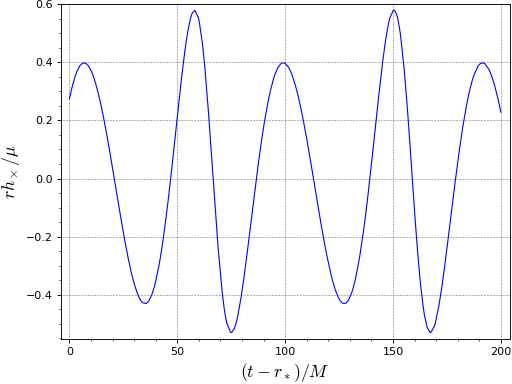
Case \(a/M=0.95\) (rapidly rotating Kerr black hole):
sage: a = 0.95 sage: h_cross_particle(a, 2., 0., pi/4, 0.) # tol 1.0e-13 -0.2681353673743396
Assessing the importance of the mode \(m=1\):
sage: h_cross_particle(a, 2., 0., pi/4, 0., m_min=2) # tol 1.0e-13 -0.3010579420748449
- kerrgeodesic_gw.gw_particle.h_cross_particle_fourier(m, a, r0, theta, l_max=10, algorithm_Zinf='spline')¶
Return the Fourier mode of a given order \(m\) of the rescaled \(h_\times\)-part of the gravitational wave emitted by a particle in circular orbit around a Kerr black hole.
The rescaled Fourier mode of order \(m\) received at the location \((t,r,\theta,\phi)\) is
\[\frac{r}{\mu} h_m^\times = {\bar A}_m^\times \cos(m\psi) + {\bar B}_m^\times \sin(m\psi)\]where \(\mu\) is the particle mass and \(\psi := \omega_0 (t-r_*) - \phi\), \(\omega_0\) being the orbital frequency of the particle and \(r_*\) the tortoise coordinate corresponding to \(r\) and \({\bar A}_m^\times\) and \({\bar B}_m^\times\) are given by Eqs. (5)-(6) above.
INPUT:
m– positive integer defining the Fourier modea– BH angular momentum parameter (in units of \(M\), the BH mass)r0– Boyer-Lindquist radius of the orbit (in units of \(M\))theta– Boyer-Lindquist colatitute \(\theta\) of the observerl_max– (default: 10) upper bound in the summation over the harmonic degree \(\ell\) in Eqs. (5)-(6)algorithm_Zinf– (default:'spline') string describing the computational method for \(Z^\infty_{\ell m}(r_0)\); allowed values are'spline': spline interpolation of tabulated data'1.5PN'(only fora=0): 1.5-post-Newtonian expansion following E. Poisson, Phys. Rev. D 47, 1497 (1993) [doi:10.1103/PhysRevD.47.1497]
OUTPUT:
tuple \(({\bar A}_m^\times, {\bar B}_m^\times)\)
EXAMPLES:
Let us consider the case \(a=0\) first (Schwarzschild black hole), with \(m=2\):
sage: from kerrgeodesic_gw import h_cross_particle_fourier sage: a = 0
\(h_m^\times\) is always zero in the direction \(\theta=\pi/2\):
sage: h_cross_particle_fourier(2, a, 8., pi/2) # tol 1.0e-13 (3.444996575846961e-17, 1.118234985040581e-16)
Let us then evaluate \(h_m^\times\) in the direction \(\theta=\pi/4\):
sage: h_cross_particle_fourier(2, a, 8., pi/4) # tol 1.0e-13 (0.09841144532628172, 0.31201728756415015) sage: h_cross_particle_fourier(2, a, 8., pi/4, l_max=5) # tol 1.0e-13 (0.09841373523119075, 0.31202073689061305) sage: h_cross_particle_fourier(2, a, 8., pi/4, l_max=5, algorithm_Zinf='1.5PN') # tol 1.0e-13 (0.11744823578781578, 0.34124272645755677)
Values of \(m\) different from 2:
sage: h_cross_particle_fourier(3, a, 20., pi/4) # tol 1.0e-13 (0.022251439699635174, -0.005354134279052387) sage: h_cross_particle_fourier(3, a, 20., pi/4, l_max=5, algorithm_Zinf='1.5PN') # tol 1.0e-13 (0.017782177999686274, 0.0) sage: h_cross_particle_fourier(1, a, 8., pi/4) # tol 1.0e-13 (0.03362589948237155, -0.008465651545641889) sage: h_cross_particle_fourier(0, a, 8., pi/4) (0, 0)
The case \(a/M=0.95\) (rapidly rotating Kerr black hole):
sage: a = 0.95 sage: h_cross_particle_fourier(2, a, 8., pi/4) # tol 1.0e-13 (0.08843838892991202, 0.28159329265206867) sage: h_cross_particle_fourier(8, a, 8., pi/4) # tol 1.0e-13 (-0.00014588821622195107, -8.179557811364057e-06) sage: h_cross_particle_fourier(2, a, 2., pi/4) # tol 1.0e-13 (-0.6021994882885746, 0.3789513303450391) sage: h_cross_particle_fourier(8, a, 2., pi/4) # tol 1.0e-13 (0.01045760329050054, -0.004986913120370192)
- kerrgeodesic_gw.gw_particle.h_particle_quadrupole(r0, u, theta, phi, phi0=0, mode='+')¶
Return the rescaled \(h_+\) or \(h_\times\) part of the gravitational radiation emitted by a particle in quasi-Newtonian circular orbit around a massive body, computed at the quadrupole approximation.
The computation is performed according to the following formulas:
\[\begin{split}\begin{array}{l} \displaystyle h_+ = 2\, \frac{\mu}{r} \frac{M}{r_0} (1+\cos^2\theta) \cos\left[2\omega_0 (t - r) + 2(\phi_0-\phi)\right] \\ \displaystyle h_\times = 4\, \frac{\mu}{r} \frac{M}{r_0} \cos\theta \sin\left[2\omega_0 (t - r) + 2(\phi_0-\phi)\right] \end{array}\end{split}\]where \(M\) is the mass of the central body, \(\mu\ll M\) the mass of the orbiting particle, \(r_0\) the orbital radius, \(\omega_0 = \sqrt{M/r_0^3}\) the corresponding orbital angular velocity and \((t, r, \theta,\phi)\) the coordinates of the observer.
INPUT:
r0– radius of the orbit (in units of \(M\), the mass of the central body)u– retarded time coordinate \(u = t - r\) of the observer (in units of \(M\))theta– colatitute \(\theta\) of the observerphi– azimuthal coordinate \(\phi\) of the observerphi0– (default: 0) phase factormode– (default:'+') string determining which GW polarization mode is considered; allowed values are'+'and'x', for respectively \(h_+\) and \(h_\times\)
OUTPUT:
the rescaled waveform \((r / \mu) h\), where \(\mu\) is the particle’s mass, \(r\) is the radial coordinate of the observer and \(h\) is either \(h_+\) or \(h_\times\) (depending on the value of
mode)
EXAMPLES:
Values of \(h_+\) for \(r_0 = 12 M\):
sage: from kerrgeodesic_gw import (h_particle_quadrupole, ....: h_plus_particle, h_cross_particle) sage: theta, phi = pi/3, 0 sage: r0 = 12. sage: porb = n(2*pi*r0^1.5) # orbital period sage: u = porb/16 sage: h_particle_quadrupole(r0, u, theta, phi) # tol 1.0e-13 0.1473139127471974 sage: h_plus_particle(0., r0, u, theta, phi) # exact value, tol 1.0e-13 0.041745779012809306 sage: h_plus_particle(0., r0, u, theta, phi, l_max=5, ....: algorithm_Zinf='1.5PN') # 1.5 PN approx, tol 1.0e-13 0.06396788402755646
Values of \(h_\times\) for \(r_0 = 12 M\):
sage: h_particle_quadrupole(r0, u, theta, phi, mode='x') # tol 1.0e-13 0.1178511301977579 sage: h_cross_particle(0., r0, u, theta, phi) # exact value, tol 1.0e-13 0.1351232731503482 sage: h_cross_particle(0., r0, u, theta, phi, l_max=5, ....: algorithm_Zinf='1.5PN') # 1.5 PN approx, tol 1.0e-13 0.14924631043762673
Values of \(h_+\) for \(r_0 = 50 M\):
sage: r0 = 50. sage: porb = n(2*pi*r0^1.5) # orbital period sage: u = porb/16 sage: h_particle_quadrupole(r0, u, theta, phi) # tol 1.0e-13 0.03535533905932738 sage: h_plus_particle(0., r0, u, theta, phi, l_max=5) # exact value, tol 1.0e-13 0.024850367000986223 sage: h_plus_particle(0., r0, u, theta, phi, l_max=5, ....: algorithm_Zinf='1.5PN') # 1.5 PN approx, tol 1.0e-13 0.026007035506911764
The difference between the exact value and the one resulting from the quadrupole approximation looks large, but actually this results mostly from some dephasing, as one can see on a plot:
sage: hp_quad = lambda t: h_particle_quadrupole(r0, t, theta, phi) sage: hc_quad = lambda t: h_particle_quadrupole(r0, t, theta, phi, mode='x') sage: hp = lambda t: h_plus_particle(0., r0, t, theta, phi, l_max=5) sage: hc = lambda t: h_cross_particle(0., r0, t, theta, phi, l_max=5) sage: umax = 2*porb sage: plot(hp_quad, (0, umax), legend_label=r'$h_+$ quadrupole', ....: axes_labels=[r'$(t-r_*)/M$', r'$r h/\mu$'], ....: title=r'$r_0=50 M$, $\theta=\pi/3$', ....: gridlines=True, frame=True, axes=False) + \ ....: plot(hp, (0, umax), color='red', legend_label=r'$h_+$ exact') + \ ....: plot(hc_quad, (0, umax), linestyle='--', ....: legend_label=r'$h_\times$ quadrupole') + \ ....: plot(hc, (0, umax), color='red', linestyle='--', ....: legend_label=r'$h_\times$ exact') Graphics object consisting of 4 graphics primitives
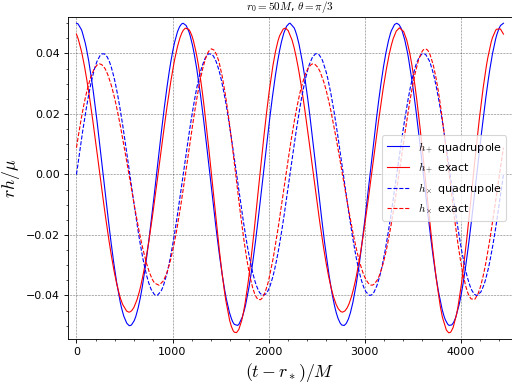
- kerrgeodesic_gw.gw_particle.h_particle_signal(a, r0, theta, phi, u_min, u_max, mode='+', nb_points=100, phi0=0, l_max=10, m_min=1, approximation=None, store=None)¶
Return a time sequence of the \(h_+\) or the \(h_\times\) part of the gravitational radiation from a particle in circular orbit around a Kerr black hole.
Note
It is more efficient to use this function than to perform a loop over
h_plus_particle()orh_cross_particle(). Indeed, the Fourier modes, which involve the computation of spin-weighted spheroidal harmonics and of the functions \(Z^\infty_{\ell m}(r_0)\), are evaluated once for all, prior to the loop on the retarded time \(u\).INPUT:
a– BH angular momentum parameter (in units of \(M\))r0– Boyer-Lindquist radius of the orbit (in units of \(M\))theta– Boyer-Lindquist colatitute \(\theta\) of the observerphi– Boyer-Lindquist azimuthal coordinate \(\phi\) of the observeru_min– lower bound of the retarded time coordinate of the observer (in units of the black hole mass \(M\)): \(u = t - r_*\), where \(t\) is the Boyer-Lindquist time coordinate and \(r_*\) is the tortoise coordinateu_max– upper bound of the retarded time coordinate of the observer (in units of the black hole mass \(M\))mode– (default:'+') string determining which GW polarization mode is considered; allowed values are'+'and'x', for respectively \(h_+\) and \(h_\times\)nb_points– (default: 100) number of points in the interval(u_min, u_max)phi0– (default: 0) phase factorl_max– (default: 10) upper bound in the summation over the harmonic degree \(\ell\)m_min– (default: 1) lower bound in the summation over the Fourier mode \(m\)approximation– (default:None) string describing the computational method; allowed values areNone: exact computation'1.5PN'(only fora=0): 1.5-post-Newtonian expansion following E. Poisson, Phys. Rev. D 47, 1497 (1993) [doi:10.1103/PhysRevD.47.1497]'quadrupole'(only fora=0): quadrupole approximation (0-post-Newtonian); seeh_particle_quadrupole()
store– (default:None) string containing a file name for storing the time sequence; ifNone, no storage is attempted
OUTPUT:
a list of
nb_pointspairs \((u, r h/\mu)\), where \(u\) is the retarded time, \(h\) is either \(h_+\) or \(h_\times\) depending on the parametermode, \(\mu\) is the particle mass and \(r\) is the Boyer-Lindquist radial coordinate of the observer
EXAMPLES:
\(h_+\) signal at \(\theta=\pi/2\) from a particle at the ISCO of a Schwarzschild black hole (\(a=0\), \(r_0=6M\)):
sage: from kerrgeodesic_gw import h_particle_signal sage: h_particle_signal(0., 6., pi/2, 0., 0., 200., nb_points=9) # tol 1.0e-13 [(0.000000000000000, 0.1536656546005028), (25.0000000000000, -0.2725878162016865), (50.0000000000000, 0.3525164756465054), (75.0000000000000, 0.047367530900643974), (100.000000000000, -0.06816472285771447), (125.000000000000, -0.10904082076122341), (150.000000000000, 0.11251491162759894), (175.000000000000, 0.2819301792449237), (200.000000000000, -0.24646401049292863)]
Storing the sequence in a file:
sage: h = h_particle_signal(0., 6., pi/2, 0., 0., 200., ....: nb_points=9, store='h_plus.d')
The \(h_\times\) signal, for \(\theta=\pi/4\):
sage: h_particle_signal(0., 6., pi/4, 0., 0., 200., nb_points=9, mode='x') # tol 1.0e-13 [(0.000000000000000, 0.275027796440582), (25.0000000000000, -0.18713017721920192), (50.0000000000000, 0.2133141583155321), (75.0000000000000, -0.531073507307601), (100.000000000000, 0.3968872953624949), (125.000000000000, -0.4154274307718398), (150.000000000000, 0.5790969355083798), (175.000000000000, -0.24074783639714234), (200.000000000000, 0.22869838143661578)]
- kerrgeodesic_gw.gw_particle.h_plus_particle(a, r0, u, theta, phi, phi0=0, l_max=10, m_min=1, algorithm_Zinf='spline')¶
Return the rescaled \(h_+\)-part of the gravitational radiation emitted by a particle in circular orbit around a Kerr black hole.
The computation is based on Eq. (2) above.
INPUT:
a– BH angular momentum parameter (in units of \(M\), the BH mass)r0– Boyer-Lindquist radius of the orbit (in units of \(M\))u– retarded time coordinate of the observer (in units of \(M\)): \(u = t - r_*\), where \(t\) is the Boyer-Lindquist time coordinate and \(r_*\) is the tortoise coordinatetheta– Boyer-Lindquist colatitute \(\theta\) of the observerphi– Boyer-Lindquist azimuthal coordinate \(\phi\) of the observerphi0– (default: 0) phase factorl_max– (default: 10) upper bound in the summation over the harmonic degree \(\ell\)m_min– (default: 1) lower bound in the summation over the Fourier mode \(m\)algorithm_Zinf– (default:'spline') string describing the computational method for \(Z^\infty_{\ell m}(r_0)\); allowed values are'spline': spline interpolation of tabulated data'1.5PN'(only fora=0): 1.5-post-Newtonian expansion following E. Poisson, Phys. Rev. D 47, 1497 (1993) [doi:10.1103/PhysRevD.47.1497]
OUTPUT:
the rescaled waveform \((r / \mu) h_+\), where \(\mu\) is the particle’s mass and \(r\) is the Boyer-Lindquist radial coordinate of the observer
EXAMPLES:
Let us consider the case \(a=0\) (Schwarzschild black hole) and \(r_0=6 M\) (emission from the ISCO):
sage: from kerrgeodesic_gw import h_plus_particle sage: a = 0 sage: h_plus_particle(a, 6., 0., pi/2, 0.) # tol 1.0e-13 0.1536656546005028 sage: h_plus_particle(a, 6., 0., pi/2, 0., l_max=5) # tol 1.0e-13 0.157759938177291 sage: h_plus_particle(a, 6., 0., pi/2, 0., l_max=5, algorithm_Zinf='1.5PN') # tol 1.0e-13 0.22583887001798497
For an orbit of larger radius (\(r_0=12 M\)), the 1.5-post-Newtonian approximation is in better agreement with the exact computation:
sage: h_plus_particle(a, 12., 0., pi/2, 0.) # tol 1.0e-13 0.11031251832047866 sage: h_plus_particle(a, 12., 0., pi/2, 0., l_max=5, algorithm_Zinf='1.5PN') # tol 1.0e-13 0.12935832450325302
A plot of the waveform generated by a particle orbiting at the ISCO:
sage: hp = lambda u: h_plus_particle(a, 6., u, pi/2, 0.) sage: plot(hp, (0, 200.), axes_labels=[r'$(t-r_*)/M$', r'$r h_+/\mu$'], ....: gridlines=True, frame=True, axes=False) Graphics object consisting of 1 graphics primitive
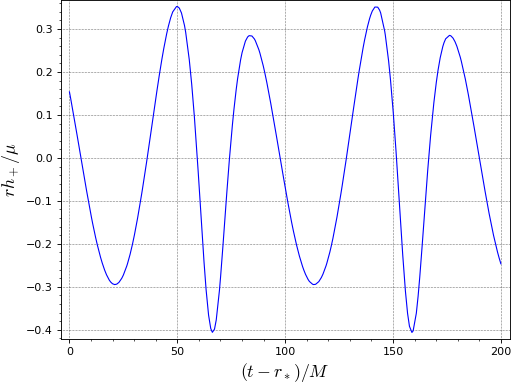
Case \(a/M=0.95\) (rapidly rotating Kerr black hole):
sage: a = 0.95 sage: h_plus_particle(a, 2., 0., pi/2, 0.) # tol 1.0e-13 0.20326150400852214
Assessing the importance of the mode \(m=1\):
sage: h_plus_particle(a, 2., 0., pi/2, 0., m_min=2) # tol 1.0e-13 0.21845811047370495
- kerrgeodesic_gw.gw_particle.h_plus_particle_fourier(m, a, r0, theta, l_max=10, algorithm_Zinf='spline')¶
Return the Fourier mode of a given order \(m\) of the rescaled \(h_+\)-part of the gravitational wave emitted by a particle in circular orbit around a Kerr black hole.
The rescaled Fourier mode of order \(m\) received at the location \((t,r,\theta,\phi)\) is
\[\frac{r}{\mu} h_m^+ = {\bar A}_m^+ \cos(m\psi) + {\bar B}_m^+ \sin(m\psi)\]where \(\mu\) is the particle mass and \(\psi := \omega_0 (t-r_*) - \phi\), \(\omega_0\) being the orbital frequency of the particle and \(r_*\) the tortoise coordinate corresponding to \(r\) and \({\bar A}_m^+\) and \({\bar B}_m^+\) are given by Eqs. (3)-(4) above.
INPUT:
m– positive integer defining the Fourier modea– BH angular momentum parameter (in units of \(M\), the BH mass)r0– Boyer-Lindquist radius of the orbit (in units of \(M\))theta– Boyer-Lindquist colatitute \(\theta\) of the observerl_max– (default: 10) upper bound in the summation over the harmonic degree \(\ell\) in Eqs. (3)-(4)algorithm_Zinf– (default:'spline') string describing the computational method for \(Z^\infty_{\ell m}(r_0)\); allowed values are'spline': spline interpolation of tabulated data'1.5PN'(only fora=0): 1.5-post-Newtonian expansion following E. Poisson, Phys. Rev. D 47, 1497 (1993) [doi:10.1103/PhysRevD.47.1497]
OUTPUT:
tuple \(({\bar A}_m^+, {\bar B}_m^+)\)
EXAMPLES:
Let us consider the case \(a=0\) first (Schwarzschild black hole), with \(m=2\):
sage: from kerrgeodesic_gw import h_plus_particle_fourier sage: a = 0 sage: h_plus_particle_fourier(2, a, 8., pi/2) # tol 1.0e-13 (0.2014580652208302, -0.06049343736886148) sage: h_plus_particle_fourier(2, a, 8., pi/2, l_max=5) # tol 1.0e-13 (0.20146097329552273, -0.060495372034569186) sage: h_plus_particle_fourier(2, a, 8., pi/2, l_max=5, algorithm_Zinf='1.5PN') # tol 1.0e-13 (0.2204617125753912, -0.0830484439639611)
Values of \(m\) different from 2:
sage: h_plus_particle_fourier(3, a, 20., pi/2) # tol 1.0e-13 (-0.005101595598729037, -0.021302121442654077) sage: h_plus_particle_fourier(3, a, 20., pi/2, l_max=5, algorithm_Zinf='1.5PN') # tol 1.0e-13 (0.0, -0.016720919174427588) sage: h_plus_particle_fourier(1, a, 8., pi/2) # tol 1.0e-13 (-0.014348477201223874, -0.05844679575244101) sage: h_plus_particle_fourier(0, a, 8., pi/2) (0, 0)
The case \(a/M=0.95\) (rapidly rotating Kerr black hole):
sage: a = 0.95 sage: h_plus_particle_fourier(2, a, 8., pi/2) # tol 1.0e-13 (0.182748773431646, -0.05615306925896938) sage: h_plus_particle_fourier(8, a, 8., pi/2) # tol 1.0e-13 (-4.724709221209198e-05, 0.0006867183495228116) sage: h_plus_particle_fourier(2, a, 2., pi/2) # tol 1.0e-13 (0.1700402877617014, 0.33693580916655747) sage: h_plus_particle_fourier(8, a, 2., pi/2) # tol 1.0e-13 (-0.009367442995129153, -0.03555092085651877)
- kerrgeodesic_gw.gw_particle.plot_h_particle(a, r0, theta, phi, u_min, u_max, plot_points=200, phi0=0, l_max=10, m_min=1, approximation=None, mode=('+', 'x'), color=None, linestyle=None, legend_label=('$h_+$', '$h_\\\\times$'), xlabel='$(t - r_*)/M$', ylabel=None, title=None, gridlines=True)¶
Plot the gravitational waveform emitted by a particle in circular orbit around a Kerr black hole.
INPUT:
a– BH angular momentum parameter (in units of \(M\), the black hole mass)r0– Boyer-Lindquist radius of the orbit (in units of \(M\))theta– Boyer-Lindquist colatitute \(\theta\) of the observerphi– Boyer-Lindquist azimuthal coordinate \(\phi\) of the observeru_min– lower bound of the retarded time coordinate of the observer (in units of \(M\)): \(u = t - r_*\), where \(t\) is the Boyer-Lindquist time coordinate and \(r_*\) is the tortoise coordinateu_max– upper bound of the retarded time coordinate of the observer (in units of \(M\))plot_points– (default: 200) number of points involved in the sampling of the interval(u_min, u_max)phi0– (default: 0) phase factorl_max– (default: 10) upper bound in the summation over the harmonic degree \(\ell\)m_min– (default: 1) lower bound in the summation over the Fourier mode \(m\)approximation– (default:None) string describing the computational method; allowed values areNone: exact computation'1.5PN'(only fora=0): 1.5-post-Newtonian expansion following E. Poisson, Phys. Rev. D 47, 1497 (1993) [doi:10.1103/PhysRevD.47.1497]'quadrupole'(only fora=0): quadrupole approximation (0-post-Newtonian); seeh_particle_quadrupole()
mode– (default:('+', 'x')) string determining the plotted quantities: allowed values are'+'and'x', for respectively \(h_+\) and \(h_\times\), as well as('+', 'x')for plotting both polarization modescolor– (default:None) a color (ifmode='+'or'x') or a pair of colors (ifmode=('+', 'x')) for the plot(s); ifNone, the default colors are'blue'for \(h_+\) and'red'for \(h_\times\)linestyle– (default:None) a line style (ifmode='+'or'x') or a pair of line styles (ifmode=('+', 'x')) for the plot(s); ifNone, the default style is a solid linelegend_label– (default:(r'$h_+$', r'$h_\times$')) labels for the plots of \(h_+\) and \(h_\times\); used only ifmodeis('+', 'x')xlabel– (default:r'$(t - r_*)/M$') label of the \(x\)-axisylabel– (default:None) label of the \(y\)-axis; ifNone,r'$(r/\mu)\, h_+$'is used formode='+',r'$(r/\mu)\, h_\times$'formode='x'andr'$(r/\mu)\, h_{+,\times}$'formode=('+', 'x')title– (default:None) plot title; ifNone, the title is generated froma,r0andtheta(see the example below)gridlines– (default:True) indicates whether the gridlines are to be plotted
OUTPUT:
a graphics object
EXAMPLES:
Plot of the gravitational waveform generated by a particle orbiting at the ISCO of a Kerr black hole with \(a=0.9 M\):
sage: from kerrgeodesic_gw import plot_h_particle sage: plot_h_particle(0.9, 2.321, pi/4, 0., 0., 70.) Graphics object consisting of 2 graphics primitives
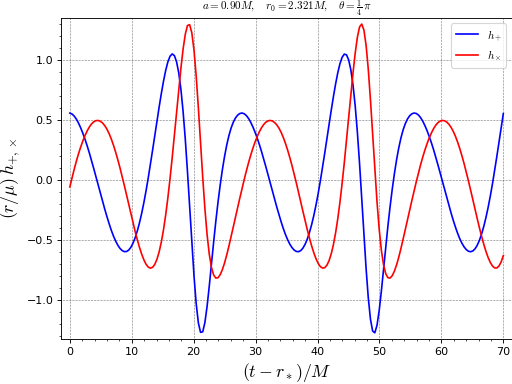
Plot of \(h_+\) only, with some non-default options:
sage: plot_h_particle(0.9, 2.321, pi/4, 0., 0., 70., mode='+', ....: color='green', xlabel=r'$u/M$', gridlines=False, ....: title='GW from ISCO, $a=0.9M$') Graphics object consisting of 1 graphics primitive
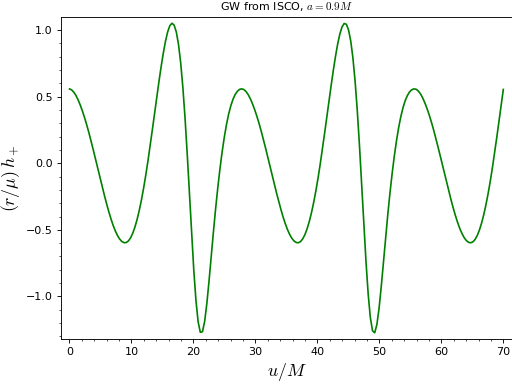
- kerrgeodesic_gw.gw_particle.plot_spectrum_particle(a, r0, theta, mode='+', m_max=10, l_max=10, algorithm_Zinf='spline', color='blue', linestyle='-', thickness=2, legend_label=None, offset=0, xlabel=None, ylabel=None, title=None, gridlines=True)¶
Plot the Fourier spectrum of the gravitational radiation emitted by a particle in equatorial circular orbit around a Kerr black hole.
The Fourier spectrum is defined by the following sequence indexed by \(m\):
\[H^{+,\times}_m(\theta) := \frac{r}{\mu} \sqrt{(A_m^{+,\times}(\theta))^2 + (B_m^{+,\times}(\theta))^2}\]where the functions \(A_m^+\), \(B_m^+\), \(A_m^\times\), \(B_m^\times\) are defined by (2).
INPUT:
a– BH angular momentum parameter (in units of \(M\), the BH mass)r0– Boyer-Lindquist radius of the orbit (in units of \(M\))theta– Boyer-Lindquist colatitute \(\theta\) of the observermode– (default:'+') string determining which GW polarization mode is considered; allowed values are'+'and'x', for respectively \(h_+\) and \(h_\times\)m_max– (default: 10) maximal value of \(m\)l_max– (default: 10) upper bound in the summation over the harmonic degree \(\ell\)algorithm_Zinf– (default:'spline') string describing the computational method for \(Z^\infty_{\ell m}(r_0)\); allowed values are'spline': spline interpolation of tabulated data'1.5PN'(only fora=0): 1.5-post-Newtonian expansion following E. Poisson, Phys. Rev. D 47, 1497 (1993) [doi:10.1103/PhysRevD.47.1497]
color– (default:'blue') color of vertical lineslinestyle– (default:'-') style of vertical lineslegend_label– (default:None) legend label for this spectrumoffset– (default: 0) horizontal offset for the position of the vertical linesxlabel– (default:None) label of the x-axis; if none is provided, the label is set to \(m\)ylabel– (default:None) label of the y-axis; if none is provided, the label is set to \(H_m^{+,\times}\)title– (default:None) plot title; ifNone, the title is generated froma,r0andthetagridlines– (default:True) indicates whether the gridlines are to be plotted
OUTPUT:
a graphics object
EXAMPLES:
Spectrum of gravitational radiation generated by a particle orbiting at the ISCO of a Schwarzschild black hole (\(a=0\), \(r_0=6M\)):
sage: from kerrgeodesic_gw import plot_spectrum_particle sage: plot_spectrum_particle(0, 6., pi/2) Graphics object consisting of 10 graphics primitives
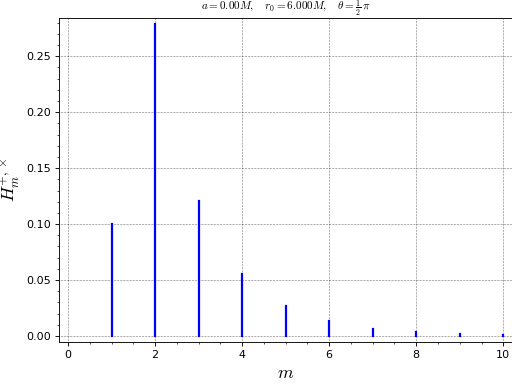
- kerrgeodesic_gw.gw_particle.radiated_power_particle(a, r0, l_max=None, m_min=1, approximation=None)¶
Return the total (i.e. summed over all directions) power of the gravitational radiation emitted by a particle in circular orbit around a Kerr black hole.
The total radiated power (or luminosity) \(L\) is computed according to the formula:
\[L = \frac{\mu^2}{4\pi} \sum_{\ell=2}^{\infty} \sum_{{\scriptstyle m=-\ell\atop \scriptstyle m\not=0}}^\ell \frac{\left| Z^\infty_{\ell m}(r_0) \right| ^2}{(m\omega_0)^2}\]INPUT:
a– BH angular momentum parameter (in units of \(M\), the BH mass)r0– Boyer-Lindquist radius of the orbit (in units of \(M\))l_max– (default:None) upper bound in the summation over the harmonic degree \(\ell\); ifNone,l_maxis determined automatically from the available tabulated datam_min– (default: 1) lower bound in the summation over the Fourier mode \(m\)approximation– (default:None) string describing the computational method; allowed values areNone: exact computation'1.5PN'(only fora=0): 1.5-post-Newtonian expansion following E. Poisson, Phys. Rev. D 47, 1497 (1993) [doi:10.1103/PhysRevD.47.1497]'quadrupole'(only fora=0): quadrupole approximation (0-post-Newtonian); seeh_particle_quadrupole()
OUTPUT:
rescaled radiated power \(L\, (M/\mu)^2\), where \(M\) is the BH mass and \(\mu\) the mass of the orbiting particle.
EXAMPLES:
Power radiated by a particle at the ISCO of a Schwarzschild BH:
sage: from kerrgeodesic_gw import radiated_power_particle sage: radiated_power_particle(0, 6.) 0.000937262782177525
Power radiated by a particle at the ISCO of a rapidly rotating Kerr BH (\(a=0.98 M\)):
sage: radiated_power_particle(0.98, 1.61403) # tol 1.0e-13 0.08629927053494096
Power computed according to various approximations:
sage: radiated_power_particle(0, 6., approximation='1.5PN') # tol 1.0e-13 0.0010435864384751143 sage: radiated_power_particle(0, 6., approximation='quadrupole') # tol 1.0e-13 0.000823045267489712
Let us check that at large radius, these approximations get closer to the actual result:
sage: radiated_power_particle(0, 50.) # tol 1.0e-13 1.9624555021692417e-08 sage: radiated_power_particle(0, 50., approximation='1.5PN') # tol 1.0e-13 1.958318200436188e-08 sage: radiated_power_particle(0, 50., approximation='quadrupole') # tol 1.0e-13 2.0480000000000002e-08
- kerrgeodesic_gw.gw_particle.secular_frequency_change(a, r0, l_max=None, m_min=1, approximation=None)¶
Return the gravitational-radiation induced change of the orbital frequency of a particle in circular orbit around a Kerr black hole.
INPUT:
a– BH angular momentum parameter (in units of \(M\), the BH mass)r0– Boyer-Lindquist radius of the orbit (in units of \(M\))l_max– (default:None) upper bound in the summation over the harmonic degree \(\ell\); ifNone,l_maxis determined automatically from the available tabulated datam_min– (default: 1) lower bound in the summation over the Fourier mode \(m\)approximation– (default:None) string describing the computational method; allowed values areNone: exact computation'1.5PN'(only fora=0): 1.5-post-Newtonian expansion following E. Poisson, Phys. Rev. D 47, 1497 (1993) [doi:10.1103/PhysRevD.47.1497]'quadrupole'(only fora=0): quadrupole approximation (0-post-Newtonian); seeh_particle_quadrupole()
OUTPUT:
rescaled fractional change in orbital frequency \(\dot{\omega}_0/\omega_0 \, (M^2/\mu)\), where \(M\) is the BH mass and \(\mu\) the mass of the orbiting particle.
EXAMPLES:
Relative change in orbital frequency change at \(r_0 = 10 M\) around a Schwarzschild black hole:
sage: from kerrgeodesic_gw import secular_frequency_change sage: secular_frequency_change(0, 10) # tol 1.0e-13 0.002701529506901975 sage: secular_frequency_change(0, 10, approximation='quadrupole') # tol 1.0e-13 0.00192
At larger distance, the quadrupole approximation works better:
sage: secular_frequency_change(0, 50) # tol 1.0e-13 3.048598175592674e-06 sage: secular_frequency_change(0, 50, approximation='quadrupole') # tol 1.0e-13 3.072e-06
At the ISCO, \(\dot{\omega}_0\) diverges:
sage: secular_frequency_change(0, 6) +infinity
while the quadrupole approximation would have predict a finite value there:
sage: secular_frequency_change(0, 6, approximation='quadrupole') # tol 1.0e-13 0.014814814814814817
Case of a Kerr black hole:
sage: secular_frequency_change(0.5, 6) # tol 1.0e-13 0.020393023677356764